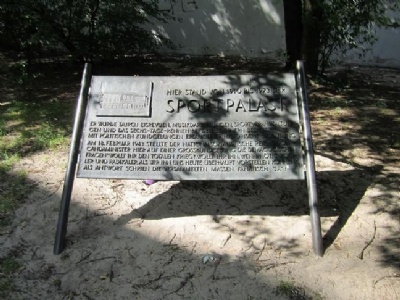Berlin – Sport Palace
This multisport arena with seating for about 15,000 spectators was built in 1910. The stadium not only became a venue for sporting events but was also used for political mass meetings by several parties during the turbulent Weimar Republic. The Nazis held several meetings in the late twenties and early thirties. The two perhaps best-known speeches held in the arena are Hitler’s first speech as chancellor on February 10, 1933, and Joseph Goebbel’s Total War speech, February 18, 1943.
Hitler’s speech on February 10, 1933, took place in front of a crowded Sports palace and was preceded by a massive preparatory work on the part of Goebbels. Before Hitler, Goebbels spoke of the great changes that had taken place and were underway in Germany. Goebbels boasted that Hitler’s speech would be broadcast live and could reach about twenty million listeners. The speech was also filmed and the arena was decorated with banners with anti-communist messages. Goebbels presented Hitler under pomp and boast of drum-rolls, flags and resounding Heil Hitler salutes. Hitler wore uniform and entered the arena surrounded by a posse of SA guards. Goebbels lyrically described to the radio listeners the spectacle that took place in the arena. When Hitler entered the podium, there was a silence among the spectators. Hitler just stood at the podium and seemed to be taken by the moment, hesitant and flipped a little nervously among his papers he had in front of him. The spectators eagerly waited for the first word, but Hitler kept them waiting, all to build up a excitement and anticipation, everything was planned to get the best possible effect. Then Hitler began to grop and almost a little nervously talk about the failure of the Weimar Republic and the rise of the Nazi party. But as Hitler got warmer, he began to gesticulate and spoke both faster, louder and more emotionally.
Hitler’s speech on February 10, 1933, took place in front of a crowded Sports palace and was preceded by a massive preparatory work on the part of Goebbels. Before Hitler, Goebbels spoke of the great changes that had taken place and were underway in Germany. Goebbels boasted that Hitler’s speech would be broadcast live and could reach about twenty million listeners. The speech was also filmed and the arena was decorated with banners with anti-communist messages. Goebbels presented Hitler under pomp and boast of drum-rolls, flags and resounding Heil Hitler salutes. Hitler wore uniform and entered the arena surrounded by a posse of SA guards. Goebbels lyrically described to the radio listeners the spectacle that took place in the arena. When Hitler entered the podium, there was a silence among the spectators. Hitler just stood at the podium and seemed to be taken by the moment, hesitant and flipped a little nervously among his papers he had in front of him. The spectators eagerly waited for the first word, but Hitler kept them waiting, all to build up a excitement and anticipation, everything was planned to get the best possible effect. Then Hitler began to grop and almost a little nervously talk about the failure of the Weimar Republic and the rise of the Nazi party. But as Hitler got warmer, he began to gesticulate and spoke both faster, louder and more emotionally.
He described the political situation in Germany and what needed to be done. He promised to address all the injustices suffered by the German people during the Weimar Republic. He thanked them for the trust the people had given him and asked for their help to save Germany and establish its former glory. An establishment that would require sacrifices and that he, as a man of the people, was prepared to share with them. He did not speak of classes, but of the people as one common denominator where no one was above anyone else. He attacked Marxism (Communism) as the main cause of Germany’s suffering, but left out the Jews. Goebbels, on the other hand, had warned before Hitler’s speech that soon the patience was over and that one would ”clog the mouth of the cheeky Jews”. At the end of the speech, Hitler was sweaty and he ended the speech by being convinced that Germany’s greatness and glory would be restored and gave the speech a religious touch when he ended it with a ”AMEN”. Immediately after the speech, Goebbels went up on the podium and brought out a threefold Heil and Hitler left the arena surrounded by his guards.
Goebbels’ speech on February 18, 1943, is probably the most famous speech given by a Nazi leader. The speech is extremely well orchestrated and is held in front of a meticulous selected audience. its design and implementation is classified as a rhetorical masterpiece. To begin with, it is important to look at the context of the speech. In 1943, Winston Churchill and President Franklin Roosevelt met in Casablanca. During the meeting it was decided that nothing but Germany’s unconditional surrender was accepted. In 1943, the Germans lost the battle of Stalingrad. Psychological warfare was at its best, and Britain asked whether the German people had not lost their confidence in Hitler. Goebbels responded to Britain’s doubts about the German people’s belief in Hitler that it was still unshakable. He explained that the German people and Hitler were inseparable and that they were prepared to follow Hitler’s will no matter what the situation looked like (Führer befehl, wir folgen). He also explained that the demand for unconditional surrender meant that the German people could expect no mercy from their enemies.
The demand for unconditional surrender had, according to Goebbels, brought the German people and Hitler even closer together. But to bring the war to a happy end for Germany (Nazis), a total war was required in which the whole society was subjected to the war both psychologically and materially. Unlike the Soviet Union, which had already largely converted its industry for military purposes before the war, this was not the case with Germany. But after Stalingrad this would change and it was Goebbels task to win over the people for this purpose. The highlight of the speech was when Goebbels asked the audience if they wanted a total war (Ich frage euch: Wollt ihr den totalen Krieg? Wollt ihr ihn, wenn nötig, totaler und radikaler, als wir ihn uns heute überhaupt erst vorstellen können?). The audience stood up and during the storming applause produced a unified YES.
But Total war in which every resource, material as human was mobilized was introduced only after the attempt on Hitler’s life in July 1944. Hitler then appointed Goebbels as Reichsbevollmächtigter für den totalen Kriegseinsatz an der Heimatfront, which gave him the responsibility to mobilize the last available resources of men. People who were actually too old for military service and people who worked in industries. In this way, Goebbels managed to scrape together another 1,000,000 men to the armed forces. These mobilized in what was called Volkssturm and were not only poorly trained, they also had inadequate equipment to influence the war at all to Germany’s advantage.
Current status: Demolished with monument (2011).
Address: Potsdamer Strasse 172, 10783 Berlin.
Get there: Metro to Bülowstrasse Station.
Follow up in books: Kershaw, Ian: Hitler – A Biography (2008).


To convince people, Hitler and Goebbels turned to people’s feelings rather than using rational political arguments. Feelings that did not question the methods of dealing with Germany’s problems. The speeches often contain prophecies about disasters occurring or that disasters have been avoided through forced measures in order to save Germany. Germany was seen as victim on the brink of disaster surrounded by enemies where only a union of party, state and citizens could save Germany.